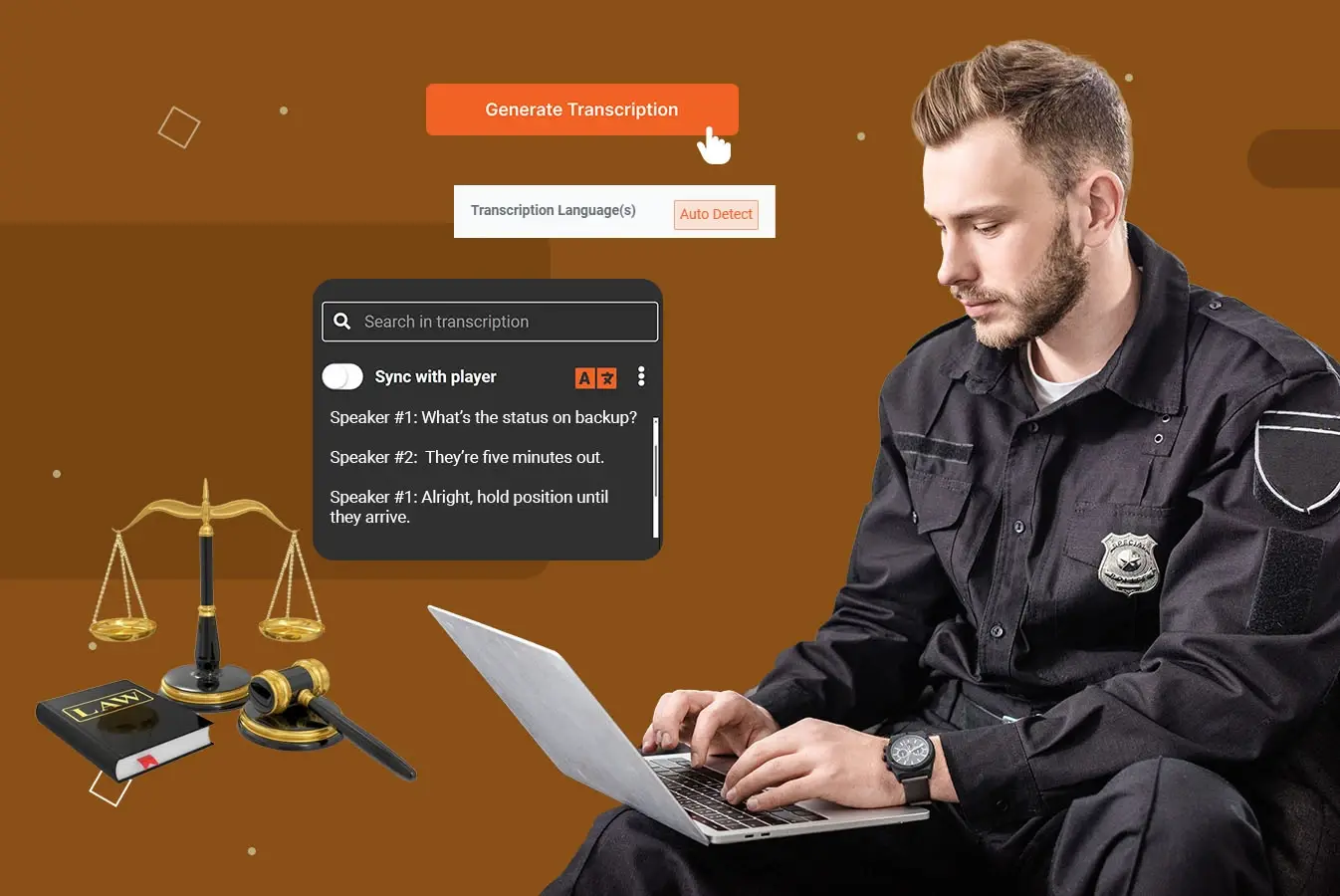Transcribing video and audio evidence into legal transcripts is an essential task in the criminal justice process. From presenting evidence in court to making appeals, legal transcripts come in handy for many reasons.
In some courts, stakeholders are legally obligated to provide transcripts, and they need to be accurate and kept secure for admissibility in court. That's why law enforcement officers, prosecutors, courts and other stakeholders in the criminal justice system seek out legal transcription services for criminal justice proceedings.
It's not simple, though. Video and audio recordings can be several hours long, and transcribing them can demand a significant amount of time and skills.
If you want to transcribe an-hour long audio/video file, it could take up to 5-6 hours! Is manually transcribing the best idea?
Manual and automatic transcription are both meant to achieve the same end result. However, both of them come with their own set of advantages and disadvantages.
In this blog, we'll take a look at the pros and cons of both manual and automatic transcription and discuss how to obtain the best results for legal transcription.
What is Legal Transcription?
Legal transcription refers to converting speech-to-text from audio or video content such as digital evidence for legal procedures. Legal transcripts have several use cases, from clarifying specific points of a piece of evidence in court and making appeals to being legally obligated for legal proceedings.
Learn More: 4 Reasons Law Enforcement Agencies Need Legal Transcription
Legal transcripts make it easier to analyze and present evidence. For example, lawyers can use them as legal documents to present in court. Digital platforms even enable you to search within transcripts to search for details and make the process more efficient.
Automatic Transcription vs Manual Transcription: What's the Difference?

Manual transcription involves a person who listens to the entire audio or video recording and manually writes it down in a text format.
In contrast, automatic transcription uses artificial intelligence to convert speech to text. Systems or programs that provide automatic transcription allow you to upload a video or audio file and use artificial intelligence to transcribe the media.
The AI engine first identifies the language of the speaker, identifies individual words and then matches these words with its vocubalory. It then returns the words that best match the audio, but the process doesn't end here. The AI analyzes the entire sentence to check if it makes sense. Certain AI engines also remove background noise to better transcribe the audio file.
AI generated legal transcripts may not be the most accurate. In fact, there are pros and cons to both of these transcription methods.
Let's look at them.
Time & Resources
As mentioned previously, transcribing an hour of audio or video file can take up to 5-6 hours. It also takes up resources as you need a dedicated person for the job.
On the other hand, automatic transcription is much quicker and it's estimated that an hour of audio can be transcribed in about 15 minutes (about 1/4th the time). It also does not require a dedicated resource to do the job.
Accuracy
Legal transcripts need to be accurate in order to be credible and admissible for legal and criminal justice purposes in court. If they are not accurate, you might be at risk of being under legal action.
Manual transcription wins out on this one. Human transcriptionists have years of experience and practice that are difficult to match by a program or machine.
This does not mean that automatic transcription can't be highly accurate. If there's no background noise and the voice is clear, you can get a very similar result to manual transcription.
The accuracy of automatic transcription depends on the quality of the sound and how much it's compressed, the background noise, the amount of crosstalk, and general accent of the speaker.
This is a video that has been transcribed using AI. Look closely and you'll find a few errors in between.
Terminology, Nouns & Jargon

Jargons are phrases that are specific to a particular industry or group. These create issues in both manual and automatic transcriptions.
For manual transcriptions, the person doing the job can always run a Goolge search and confirm the jargon or phrase. The chances of not capturing it well are low.
These are usually more of an issue in automatic transcription where AI is usually not able to recognize jargon and returns it as the best word it can attempt.
The issue is the same for proper nouns. Don't know if you noticed, but our platform's AI pronounced EnterpriseTube as "Enterprise use" at 0:51 in the video above.
Privacy & Security

Privacy is of the utmost importance when it comes to legal scenarios and situations. Legal entities and organizations may be wary of sharing files and documents outside of the organization.
Manual transcription usually involves sending your video or audio file to a third party service. While all legal transcription service providers need to sign a non-disclosure agreement (NDA), there is still a higher risk.
In automatic transcription, law enforcement agencies, the DA's office, attorneys, etc. can get a legal transcription without ever having any third party get access to it.
Automatic transcription, if done in a secure cloud or in a container in your on-premise datacenter (like we do), makes sure data is not accessed by unauthorized individuals.
Which One Should You choose?
Choosing automatic or manual transcription depends on your priorities. If you want to maintain complete accuracy and avoid missing legal jargon elements, manual services for legal transcription can ensure so.
However, if your evidence or legal documents demand a high level of privacy and you need those transcriptions faster, then automatic transcription helps you do the job in a fraction of the same time.
But considering the importance of each of these elements, automatic or manual transcription alone might not be good enough...
But what if you could have the best of both worlds?
Combine Automatic and Manual Transcription for the Best Solution

As you can see in the screenshot above, you can easily edit the transcription to correct any minor issues. VIDIZMO offers automatic transcription within its platform. Here's how it works:
- AI automatically transcribes videos and speakers can be in around 39 languages.
- As AI is not 100% accurate, users can make the edits within the application and the process is faster than writing from scratch.
- All transcriptions can be securely stored and processed in any commercial or Government cloud, or even in your on-premise datacenter.
You can get automatic transcription for legal purposes through two different VIDIZMO products:
VIDIZMO Digital Evidence Management System
VIDIZMO Digital Evidence Management System (DEMS) provides an end-to-end solution for managing digital evidence and legal documents. You can store and manage evidence in a centralized place and makes it easier to create legal transcriptions as it provides both automatic and manual transcription for all audio and video files.
Other important features include:
- Generate a one-click chain of custody report for all actions on an evidence file.
- Integrate with existing systems such as body-worn cameras, RMS, CAD, etc.
- Securely share evidence such that receipents can't download them, or share them ahead.
- Use AI to automatically redact faces, object and other PII in evidence files to prepare them for court.
- All video evidence is optimized for playback using transcoding, eCDN Delivery, HLS streaming, etc.
VIDIZMO EnterpriseTube
VIDIZMO EnterpriseTube is a Gartner recognized enterprise video platform, which offers organizations a YouTube-like platform to upload and manage video content. Here's what is looks like.
.jpg?width=7927&name=EnterpriseTube%20New%20Layout-02%20(4).jpg)
Highlighted features include:
- Optimized video playback for varying devices and bandwidth conditions.
- Add quizzes, forms, and handouts to videos, and users can comment and collaborate just like YouTube.
- AI-generated transcription and translations of these transcriptions.
- Secure sharing of videos such that reciepents can't download them, share them ahead or have limited views.
Posted by Zohaib Khan & Shahan Zafar
This article is written jointly by Shahan Zafar (Product Marketing Manager) and Zohaib Khan (Product Marketing Manager).







